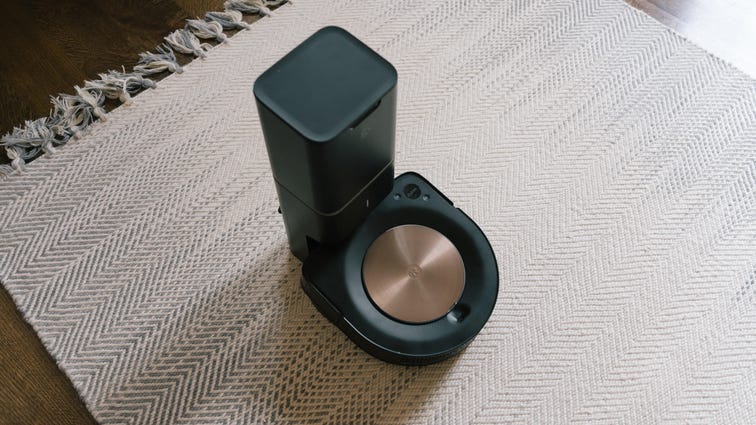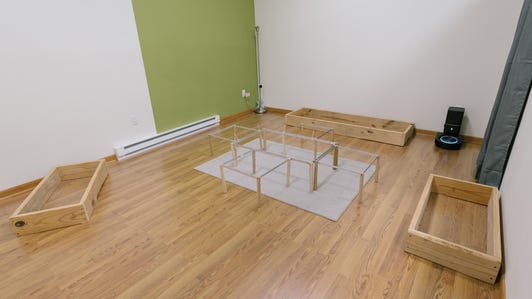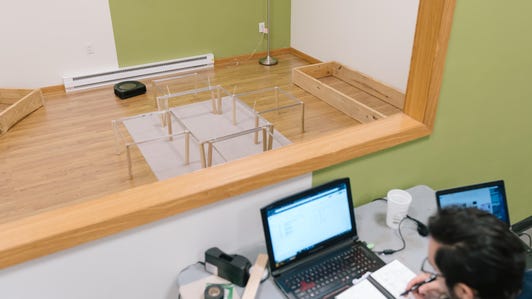Is a consistently clean floor one of your spring cleaning goals? You don't need a complicated chore wheel or cleaning schedule, and you can put the upright vacuum, broom, dust bin and mop back in the closet. We are now in the age of the smart vacuum, and there are robots to do that cleaning for us.
At one time, robot vacuums were only found in the pages of classic science fiction, or residents of Jetsons-like midcentury dream homes. That's no longer the case. They're real appliances. In fact, they're far more advanced than ever before, with models boasting an array of sophisticated sensors, CPUs, lasers and even AI-enhanced software. The fact is that if you're looking to keep your home nice and tidy, these robots are useful tools and will do the trick. Beyond dirt, a robot vacuum cleaner will pick up things like kitty litter and dust bunnies, keeping hardwood floor, tile floor, area rugs and carpets spick-and-span.
Nonetheless, living the robotic vacuum cleaner dream can set you back a hefty sum -- some cost as much as four figures. While you don't have to spend that much, you do get a lot in return. That includes self-emptying dust bins, multiple room and floor mapping, powerful suction and thoughtfully designed hardware.
Despite all this sophistication, however, none of these machines can really replace a mop and human exertion.
To choose the best robot vacuum, I spent over 120 hours (that's a lot of time) torture-testing a group of 12 robotic cleaning vacuums for things like suction power, their ability to perform on carpets and hard flooring, and how well they performed during each cleaning cycle. Among them are brand-new models that have recently launched, flagship models and compelling options offered across numerous online retailers. I excluded older models that likely won't be sold for much longer. I'll continue to update this list periodically as new models hit the market.
If someone were to give you a blank check and tell you to buy the best robot vacuum, this is the bot to get. That said, the iRobot Roomba S9 Plus has a whopping price of $1,099. For that staggering pile of cash though, this robotic vacuum delivers powerful suction and superb dirt and dust removal.
On hardwood floors this Roomba picked up an average of 93% of our test sand, the highest amount in our test group, but it struggled a bit cleaning sand from low-pile carpeting and area rugs, earning a low average dust and sand pickup of 28%.
That said, the Roomba robot vac removed an average 71% of sand from our medium pile carpet while vacuuming. Again, this is the best result that we saw on this specific test. It also cleaned up more dog hair, pet dander and allergens than any vacuum in this test group, and the bot navigates and maps multiple rooms and floors. iRobot has also updated its app to let you designate "keep out zones" that you want the S9 Plus to avoid when cleaning. The app also lets you use voice commands to immediately clean a room using Alexa or Google Voice Assistant.
The robot zipped through our test room in a short average time of 25 minutes, too. You can link the S9 Plus to the Roomba app and your home Wi-Fi as well. Best of all is the Roomba S9 Plus' CleanBase docking station. The dock both charges the robot's battery and empties its dustbin automatically, making cleaning even easier and keeping you from worrying about battery life. Now that's convenient.
For less than half the price of the Roomba S9 Plus, the $600 Neato's D7 vacuums up dirt, dust and messes almost as well, making it the best robot vacuum at a midrange cost. On average this robotic cleaner picked up a greater amount of sand (36%) across low-pile carpet and rugs than the Roomba did.
This automatic vacuum cleaner narrowly beat the S9 Plus for cleaning power on hardwood bare floors, too, collecting an average of 95% of the sand we put down. The vac cleaned dirt, dust and sand from midpile rugs less effectively though, notching a pickup average of 47% while cleaning.
While the Neato can't match the Roomba's prowess at removing pet hair or empty its own dust bin, the D7 navigates more efficiently around furniture yet covers more ground thanks to smart robot vacuum built-in lidar laser navigation mapping. You can also control the cleaning robot using the Neato app as a remote control, as well as link it to Amazon Alexa and Google Assistant. The app allows you to designate areas of your home as off-limits to cleaning, too.
Here's a robotic vacuum that proves you don't need to blow your budget to purchase a solid robot vacuum cleaner. Even though the Robovac 11S Max costs just $250 right now, it cleans floors effectively. That's especially true when cleaning bare hardwood floors.
It managed to remove an average of 71% of our test sand from this type of surface. The bot didn't work as well cleaning carpets, earning sand-pickup averages of 21% and 27% on low-pile and mid-pile, respectively.
And thanks to this vacuum's basic navigation system, it took well over an hour to negotiate our test room. As far as time goes, that's a lot. Still, the Eufy used its runtime wisely. The vacuum covered the space well, cleaning up and leaving almost no spots untouched. The Eufy is also self-charging, so again, no need to worry about battery life or factor that into overall cleaning time. It's the best robot vacuum for value.
How we test robot vacuums
Our method for evaluating robot vacuums is straightforward, yet grueling. There are two types of tests we run. The first trial is to figure out how well a robot covers the floor while cleaning. We built an industry-standard testing room as specified by the International Electrotechnical Commission, just for this purpose. The IEC is an international standards body responsible for managing robot vacuum testing procedures, among other things, for vacuum manufacturers.
Obstacles in our test room mimic what robot vacuums run into in the real world.
Tyler Lizenby/CNETInside this room are objects designed to simulate typical obstacles a robot vac encounters for navigation as it cleans. These obstacles include wall edges, table and chair legs, couches and other furniture, and so on, plus bare tile and hardwood floors, as well as carpet.
Here's a coverage photo of the iRobot Roomba S9 Plus as it moved through our test room. You can see the Roomba S9 covered the floor well, except for one slight section in the center (left, bottom).
Gianmarco Chumbe/CNETWe mount LED lights to the top of each vacuum cleaner. The dimensions of the lights correspond to the measured nozzle width of each particular robot vacuum we test.
As robots move through the room while cleaning, a camera overhead captures a long-exposure image of the entire room in low light. That photo will then have a light trail, created by the LEDs, that shows the exact areas where the robot traveled (and its nozzle position) during its runtime. We can also see areas of the floor the vacuum may have missed or gotten stuck.

This is the coverage pattern created by the Neato D7. Its movement through our test room was very orderly, logical and effective.
Gianmarco Chumbe/CNETYou can see the navigation results of all the robot vacuums in our test group in the gallery below.
The second type of test reveals exactly how much physical debris a vacuum is able to pick up off of the floor. To mimic dirt of small particle size, we use a mixture of play-sand and landscaping sand. For bigger particle soil, we use grains of uncooked black rice. Robots then run in straight line mode across three types of flooring (low-pile carpet, medium-pile carpet and hardwood bare floors).
We test robot vacuums on three types of floor surfaces.
Tyler Lizenby/CNETWe control for the specific nozzle width of each vacuum, too. We constructed an adjustable tool to soil our test floors. It lets us lay down a strip of precise area of soil to match the nozzle dimensions for every robot. The mass of soil isn't chosen at random either. We measure a proportional amount that's related to the flooring material, type of debris, plus each vacuum's nozzle width.
Our custom-built tool lets us match soil area to a robot vacuum's nozzle width.
Tyler Lizenby/CNETWe conduct three cleaning runs (at minimum) on each floor type. We also perform cleaning tests with sand and rice separately. That comes to at least 18 tests per robot vac. We weigh the robot's dust bin both before and after each run. From there we can calculate the percentage of debris pickup for every cleaning run and the average amount of soil a machine manages to remove. Additionally we run anecdotal (visual) pet hair tests for each robot, on all three floor types.
We run robot vacuums in a straight line during the debris pickup tests.
Tyler Lizenby/CNETThe chart below shows the fine particle cleaning performance data for all of the robot vacuums we tested. It should give you a pretty good idea about their cleaning performance on different kinds of flooring surfaces. Our rice-based, medium-size particle test didn't show enough differentiation between each cleaner, which says they can all handle larger particles without trouble. For fur removal for pet owners, we judged anecdotally.
Percent soil removed
iRobot Roomba S9 Plus
Electrolux Pure i9
Neato Botvac D6 Connected
RoboRock S5 Max
Ecovacs Deebot Ozmo 950
Shark IQ 1001AE
iRobot Roomba i7 Plus
Eufy RoboVac 11s Max
Ecovacs Deebot 600
Ecovacs Deebot 500
Legend:
Sand from low-pile
Sand from hardwood
Sand from medium-pile
Note:
Results listed are the average percentage of total material removed from test surfaceWant more robot vacuum options? Here's a list of the other robot vacuums we tested besides the models listed above.
More vacuum advice and recommendations
from CNET https://ift.tt/3bAhjEd
via IFTTT










No comments:
Post a Comment